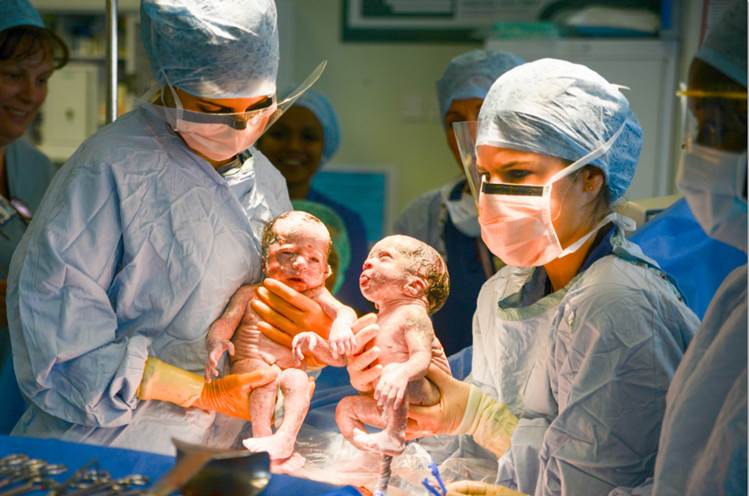Incredible growth scanning of twin caesarean and a world first in London!
 World’s first twin babies measured using the twin pregnancy growth charts have been born.
World’s first twin babies measured using the twin pregnancy growth charts have been born.
Twin babies measured using the twin pregnancy growth charts during pregnancy have been born. Mala Vast Dhuri gave birth to Kiaan and Kush, weighing 2kg and 2.1kg respectively, via caesarean section at St George’s Hospital in Tooting, London. Mala was the world’s first expectant mum to be scanned using the twin pregnancy growth charts on 6th July. On Thursday morning (27th July 2017), her identical twin boys were delivered.
The charts mean twins can be accurately measured in the womb so health professionals can instantly recognise whether they are growing appropriately. It means hundreds of tiny lives could be saved when, previously, growth issues were potentially misdiagnosed and inappropriately managed. The £25,000 research project to develop the growth charts was funded by twin parents across the country thanks to a massive fundraising appeal by multiple births charity Tamba (Twins and Multiple Births Association).
Mala, aged 37, and her husband Kiran Dhuri, aged 42, greeted their newborns on Thursday morning, with Tamba’s photographer capturing the magical moment. Mala said: “I’m over the moon to finally meet my gorgeous little boys, thanks so much to the St George’s team for ensuring the safe arrival of my babies”
Tamba CEO Keith Reed said: “Huge congratulations to Mala and Kiran. We are so pleased to see the boys delivered safely. We hope the whole family enjoy those precious early days with Kiaan and Kush. “This is an extremely important day for fetal medicine. Mala was the first mum to have her twin babies measured using the twin pregnancy growth charts. We hope these charts help many more twin babies to thrive.”
Previously, hospitals looking after women expecting twins plotted the growth measurements using singleton growth charts and clinicians had to use their judgement to decide how the babies were progressing. Dr Asma Khalil, who delivered Mala’s twins and helped develop the charts, explained: “We are now measuring all of our twin pregnancies at St George’s with the new charts. The growth charts help us to identify the difference between babies which are truly small because they not developing properly versus twins who are normally small.”
Experts say that using singleton growth charts to measure twin babies means there is an “over-diagnosis” of growth problems. Incorrectly diagnosing twins as “too small” causes anxiety for the parents and can also result in babies being delivered too early. Premature births can result in severe disabilities. Dr Khalil added: “For us to deliver early when there isn’t a reason can result in causing potential harm to the babies by delivering them early. We know that prematurity is associated with the risk of disability. “The benefits of the twin growth charts would be to reduce the number of babies needing neonatal care after birth. About 50% of multiple birth babies need some form of special unit treatment once they’re born but with these new twin growth charts we’re hoping to reduce that statistic considerably. “Of course, our primary objective is to improve healthcare provided for twin babies during pregnancy. We hope the twin pregnancy growth charts will further improve the care for multiple birth women.”
The growth charts are available worldwide in the recent versions of GE Viewpoint and Astraia software. Roland Rott, general manager of Women’s Health Ultrasound at GE Healthcare, said: “We are delighted to have been able to work with Tamba to implement the growth charts on GE software, in order to improve the monitoring of twins’ growth and ultimately the healthcare of twin babies and their mothers during pregnancy.”
Although research into twin growth during pregnancy has been conducted in the past, and studies have found a significant difference in their growth compared to singleton babies, the findings have never resulted in twin growth charts being available on hospital computer software. This means the charts are a world first. But with both companies having systems in hospitals in Europe and further afield, the growth charts will also be made available on worldwide.
To find out more about the growth charts visit www.tamba.org.uk/blog/growth-charts





